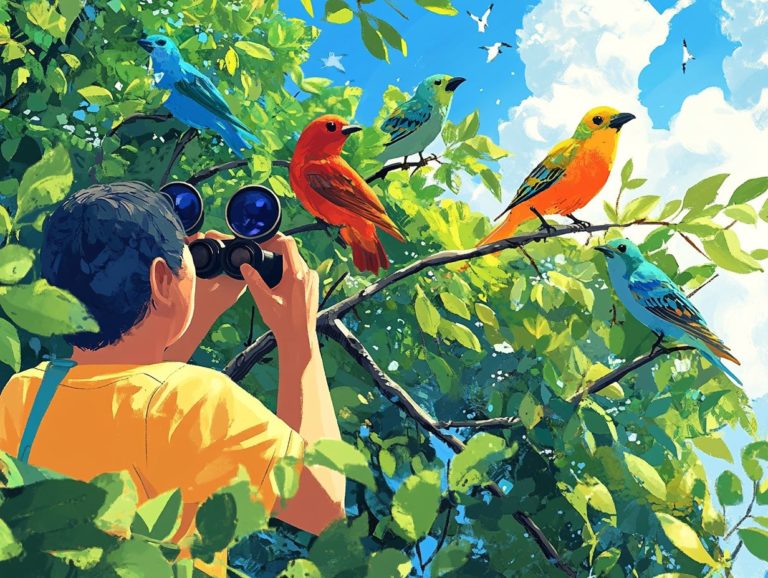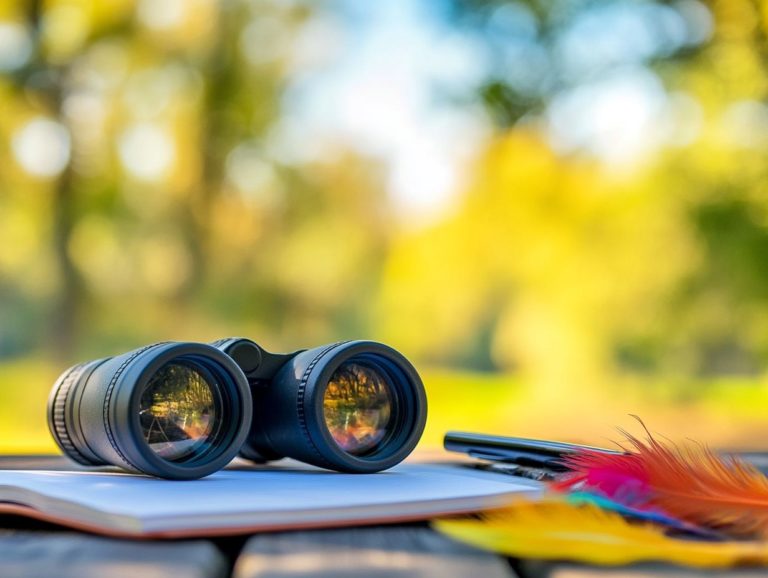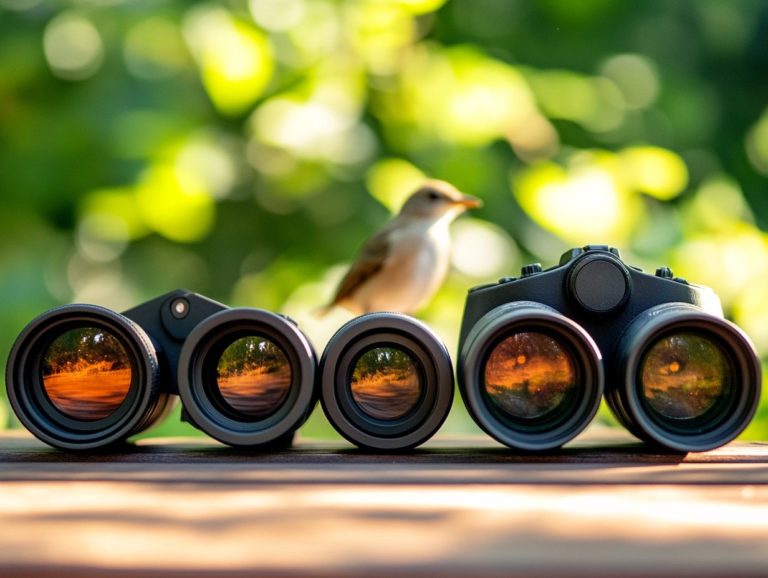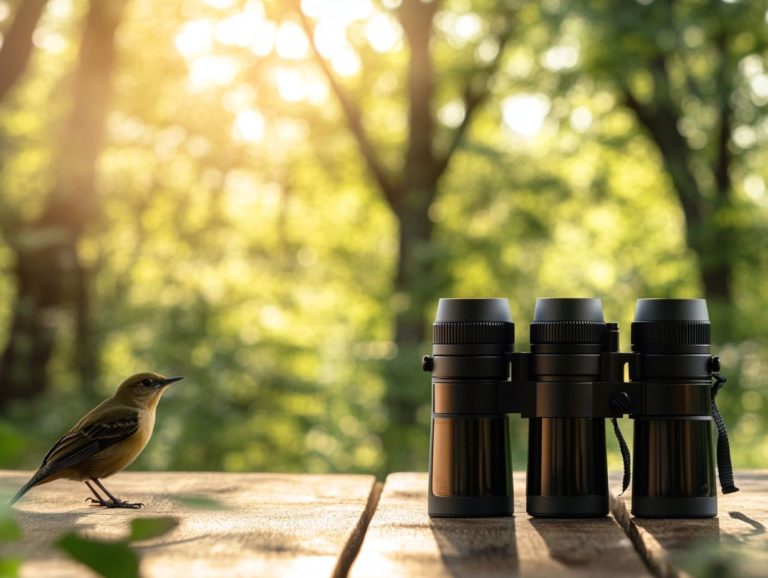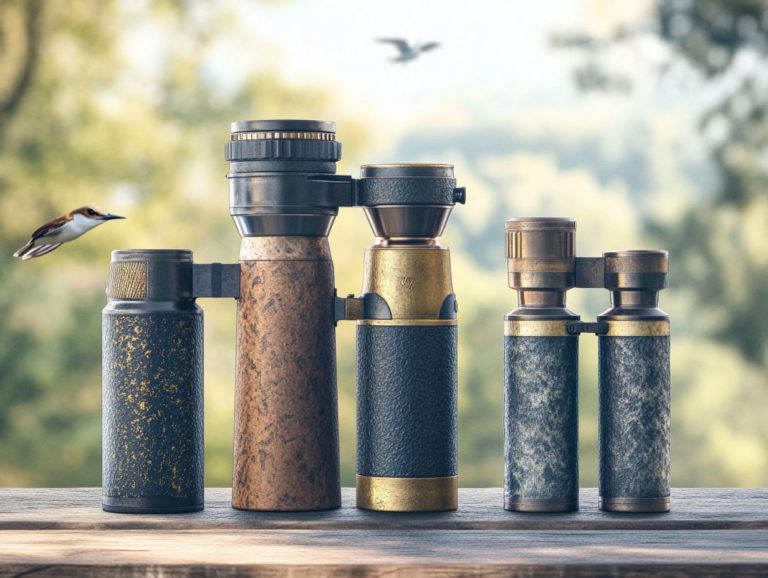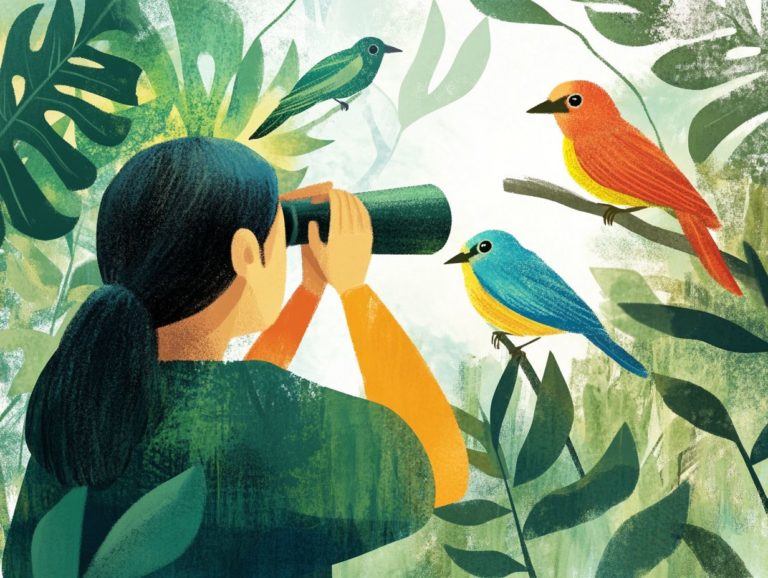Best Binoculars for Birding in Rainy Weather
Birdwatching can be an exhilarating pursuit, even when the skies are overcast and dreary. To fully embrace the experience, you must have the right pair of binoculars, especially when the rain starts to fall.
This article delves into the essential features that make binoculars perfect for birding in inclement weather, highlighting waterproof and fogproof capabilities, lens quality, magnification, and durability. You ll also discover how to select the right model, the significance of brand reputation, and other key considerations. Equip yourself with the insights needed to make an informed decision and elevate your birdwatching adventures!
Contents
- Key Takeaways:
- 1. Waterproof and Fogproof Features
- 2. Lens Coating and Quality
- 3. Magnification and Objective Lens Size
- 4. Close Focus and Field of View
- 5. Durability and Construction
- 6. Comfort and Ergonomics
- 7. Image Stabilization
- 8. Price Range
- 9. Brand Reputation and Customer Reviews
- 10. Additional Features and Accessories
- How to Choose the Right Binoculars for Birding in Rainy Weather?
- What Are the Key Features to Consider?
- What Is the Ideal Magnification for Birding in Rainy Weather?
- What Are the Different Types of Lens Coatings and Which Is Best for Rainy Conditions?
- How Can One Test the Waterproof and Fogproof Features of Binoculars?
- What Are the Recommended Brands for Binoculars for Birding in Rainy Weather?
- Frequently Asked Questions
- What are the best binoculars for birding in rainy weather?
- Why are waterproof and fog-proof binoculars important for birding in rainy weather?
- What size binoculars are best for birding in rainy weather?
- Can I use regular binoculars for birding in the rain?
- Which brands offer the best binoculars for birding in the rain?
- How should I care for my waterproof binoculars?
Key Takeaways:
- Look for waterproof and fogproof features when choosing binoculars. This will ensure clear vision and prevent damage to the lenses.
- Invest in high-quality lens coatings for clarity and glare reduction. Multi-coated lenses are ideal for birding in the rain.
- Consider lower magnification with larger objective lenses for better light gathering. This will provide a wider field of view and better light-gathering capabilities for dimmer conditions.
1. Waterproof and Fogproof Features
When you’re on the hunt for the perfect binoculars for birding, one of the most essential features to consider is whether they are waterproof and fogproof. For those looking for affordability, check out the best binoculars for bird watching on a budget. These features make your birdwatching more enjoyable, no matter the weather.
Waterproof and fogproof features protect your optics from rain or accidental splashes. They also prevent internal condensation, which could cloud your vision during sudden temperature shifts.
Brands like Nikon, Vortex, and Swarovski have built a robust reputation for delivering reliable models that come equipped with these crucial features. If you re seeking recommendations, expert birders often rave about the Vortex Diamondback series for its perfect blend of durability and affordability. If you’re looking for top-tier performance, Swarovski’s EL series is celebrated for its outstanding clarity and ability to excel in challenging conditions.
By incorporating these trustworthy options into your gear, you can concentrate on the joy of spotting your feathered friends without the nagging worry of weather-related interruptions.
2. Lens Coating and Quality
The lens coating and optical quality of binoculars are essential for elevating your viewing experience, especially if you re a birder who seeks high resolution and clarity to capture every intricate detail of wildlife. Advanced coatings work wonders in minimizing glare and enhancing light transmission, transforming each moment in nature into a vivid and immersive encounter.
Understanding the differences between multi-coated and fully multi-coated options can significantly impact your performance in various lighting conditions. Multi-coated lenses excel at reducing glare and amplifying contrast, which is crucial for spotting birds under bright sunlight. Fully multi-coated lenses provide superior light transmission, ensuring that even in those magical low-light moments at dawn or dusk, every detail is still crystal clear.
Reputable brands such as Nikon, Zeiss, and Swarovski are renowned for their exceptional lens quality, offering birders the clarity and brightness necessary to fully appreciate the natural world in all its breathtaking beauty.
Choosing the right binoculars will enhance your birdwatching experience significantly. Explore your options today to make sure you re ready for your next adventure!
3. Magnification and Objective Lens Size
Understanding magnification and objective lens size is essential for birders looking to elevate their viewing experience. These specifications directly influence the clarity and detail you can observe in distant wildlife.
For example, an 8×42 configuration strikes a fine balance between power and field of view, while a 10x setup offers greater magnification, enabling you to spot elusive birds from a distance.
Keep in mind that as magnification increases, the field of view typically decreases, which can make tracking moving birds more challenging. A larger objective lens, like 50mm, allows more light to enter, enhancing visibility during magical moments at dawn or dusk.
If you re birding in wooded areas, you might prefer a wider field of view for easier navigation. Conversely, when you’re in open landscapes, higher magnification may serve you better.
Choosing models like the Nikon Monarch or the Vortex Viper ensures you achieve the optimal balance tailored to your unique environments and observational needs.
4. Close Focus and Field of View
Close focus and field of view are essential elements that can elevate your birding experience. They enable you to appreciate the intricate details of nearby wildlife without strain.
Binoculars with close focus capabilities allow you to observe subjects just a few feet away. A wide field of view helps you track movement seamlessly as you watch birds in their natural habitat.
This combination is vital for catching glimpses of species that flit between branches or dart across open skies. Top-quality binoculars that boast impressive close focus offer remarkable adaptability to diverse environments, making them invaluable tools for both seasoned birders and newcomers.
When equipped with the right binoculars, you ll be amazed at how it enhances your ability to identify birds hidden in fluttering foliage. This enriches your overall enjoyment of the birding adventure, allowing for a more immersive and rewarding experience in nature.
5. Durability and Construction
Durability and construction quality are paramount for birders seeking reliable and lightweight binoculars for travel. This provides peace of mind during your outdoor adventures.
Quality materials enhance the longevity and performance of your binoculars, ensuring they can handle the demands of field use while remaining portable.
Top-quality binoculars often feature magnesium alloy, a strong and lightweight metal, making it a favored choice for those who explore various terrains. Rubber armor is commonly employed to shield your binoculars from impacts and harsh weather, guaranteeing functionality even in challenging environments.
Lightweight designs are especially important if you spend hours hiking or birdwatching, allowing for comfortable mobility without extra hassle. Notable models like the Nikon Monarch and Zeiss Terra embody these qualities, showcasing exceptional durability and reliability in real-world conditions.
6. Comfort and Ergonomics
When selecting binoculars for birding, comfort and ergonomics are crucial. These factors significantly influence your experience during long viewing sessions.
Features like adjustable eyecups, a lightweight design, and a well-balanced construction allow for extended use without discomfort. These considerations are essential for any serious birdwatcher.
Rubberized grips provide a secure hold, minimizing the risk of slippage during critical moments. Customizable eyecups further enhance your viewing experience by catering to your unique preferences, whether you wear glasses or not.
These ergonomic enhancements improve comfort and extend the time you can spend immersed in observing nature, leading to a more rewarding birding adventure.
When choosing binoculars, seek options that seamlessly blend comfort features with exceptional optical performance that can truly make all the difference.
Invest in quality binoculars today to observe your feathered friends without compromise!
7. Image Stabilization
Image stabilization in binoculars gives you a significant edge when birdwatching. It enhances your clarity and detail as you track elusive flying creatures. This technology minimizes vibrations and shakes, ensuring a smooth and enjoyable viewing experience. It’s especially useful for longer birdwatching sessions.
With many models available, you can choose binoculars with optical or electronic stabilization systems. This allows you to tailor your selection based on specific birding conditions and personal preferences. Many enthusiasts find that advanced stabilization capabilities help them spot rare species from a distance, reducing eye strain during extended observations. Some stabilized binoculars even feature compact designs, making them incredibly easy to carry on hikes or trips to remote locations.
The combination of innovative technology and user-friendly experience makes stabilized binoculars an essential tool for any serious birder looking to elevate their wildlife viewing adventures.
8. Price Range
The price range of binoculars can vary dramatically. This can influence your purchase decisions based on features, specifications, and overall quality. It’s essential to understand what you’re investing in. While high-quality models may come with a heftier price tag, they often deliver superior performance and durability, ensuring an exceptional birdwatching experience.
When evaluating binoculars, consider several key specifications that can justify higher costs, such as lens quality, magnification power (how much closer you can see objects), field of view, and build materials. If you’re budget-conscious, entry-level models can offer commendable performance without straining your finances, although they may lack advanced features like waterproofing or superior optics found in higher-end options.
Mid-range binoculars usually strike a perfect balance between cost and performance. They often feature better light transmission and clearer images, making them ideal for dedicated enthusiasts. Understanding these specifications enables you to make informed choices that align with your budget and birdwatching aspirations.
9. Brand Reputation and Customer Reviews
Brand reputation and customer reviews are crucial for guiding you in making informed purchase decisions. Established brands often deliver the trusted quality and performance you seek.
Among these trusted names, Zeiss, Swarovski, and Leica stand out for their exceptional optics and durability. As a birdwatcher, you’ll likely hear many positive experiences detailing how these brands enhance the joy of observing and appreciating wildlife.
Zeiss is frequently praised for its sharpness and clarity. Swarovski users rave about the lightweight design that simplifies long trips. Meanwhile, Leica enthusiasts admire its rugged construction, built to withstand various outdoor conditions.
By weighing expert recommendations and straightforward feedback from seasoned birders, you can navigate your options better and discover binoculars that elevate your birdwatching adventures to new heights.
10. Additional Features and Accessories
Additional features and accessories can truly enhance your birdwatching experience. Consider tripods for steady viewing, carrying cases for easy portability, and specialized lens cloths for maintaining your high-quality binoculars. These accessories perfectly complement your gear.
Investing in a quality field guide app is invaluable as it provides instant identification and insightful background information on various species. Additionally, lightweight backpacks designed specifically for birding can help you organize your gear, snacks, and water effortlessly for long treks in the field.
Think about incorporating a portable blind or shelter, as it can provide you with a camouflaged vantage point for unobtrusive observation. When selecting accessories, prioritize features like waterproof materials, lightweight designs, and adjustable components, all tailored to meet the unique needs of dedicated bird watchers like you.
How to Choose the Right Binoculars for Birding in Rainy Weather?
Choosing the right binoculars for birding in rainy weather demands careful attention to features like waterproof and fog-resistant capabilities. For optimal performance, consider the top 5 birding binoculars for extreme weather. This ensures you’ll see every vibrant detail, even when it’s pouring!
Many models crafted for wet conditions promise durability and significantly enhance your overall viewing experience. They are essential tools for avid birders.
When evaluating your options, pay close attention to waterproof ratings, typically indicated by an IPX score a rating that shows how waterproof the binoculars are. User experiences in rainy weather are invaluable; models with rubberized armor often provide a firmer grip, reducing the risk of slippage when conditions get tricky.
Opt for binoculars with multi-coated lenses. These improve light transmission and minimize glare, ensuring you capture brighter images even in dim settings. The Nikon Prostaff 3S and the Vortex Diamondback HD stand out as excellent choices, celebrated for their sturdy construction and optical performance. With their sturdy design, you can dive into your birding adventures, rain or shine!
What Are the Key Features to Consider?
When selecting binoculars for birding in rainy weather, prioritize key features such as waterproof and fog-resistant construction, close focus capabilities, and overall optical quality. Additionally, consider investing in waterproof gear for bird watching in rainy weather; these attributes are vital for ensuring a successful experience, even in challenging conditions.
Waterproof construction prevents moisture from seeping into the binoculars, protecting the internal optics. This allows you to confidently use them in light rain without worry. Fog-resistant specifications, achieved through nitrogen or argon gas purging, ensure that the internal lenses remain free from condensation a common nuisance when transitioning from humid to cooler environments.
Close focus capabilities help you observe birds at closer distances. This is especially advantageous in rainy weather, when avian creatures often seek shelter. You ll be able to see their behavior and plumage in detail that you might otherwise miss.
All these features enhance your birding experience, making it possible to relish sightings even when the weather is less than ideal.
What Is the Ideal Magnification for Birding in Rainy Weather?
The ideal magnification for your birding adventures in rainy weather typically hovers between 8x and 10x. This range strikes a perfect balance between detail and clarity, especially when the light isn t playing nice.
Your choice of magnification can significantly impact your overall birding experience. While higher magnifications may promise greater detail, they can introduce shakiness in wet conditions, making it difficult to maintain a steady image. The reduced light typical of rainy days can further diminish brightness and contrast when you crank up the magnification.
Many seasoned birders recommend sticking with the lower magnification range to combat these challenges. This provides a more stable view and helps you track movements swiftly. Ultimately, opting for 8x or 10x magnification is about finding the sweet spot between clarity and the practical realities of the environment, ensuring that the joys of birdwatching remain vibrant, even when the skies are less than cooperative.
What Are the Different Types of Lens Coatings and Which Is Best for Rainy Conditions?
Different types of lens coatings significantly impact how your binoculars perform in rainy conditions. Fully multi-coated lenses are the top choice for maximizing light transmission and reducing glare. These coatings enhance optical quality, allowing you to enjoy clear and precise images, even when the skies are overcast or drizzling.
In addition to fully multi-coated lenses, consider anti-fog and water-repellent coatings. These features improve visibility by preventing moisture build-up on the lens surface, so you can observe without interruption, even during sudden downpours.
Highly regarded models, such as the Nikon Prostaff 3S and Vortex Diamondback, come equipped with these advanced coatings. They are the go-to options for enthusiasts like you. Users often praise these enhancements for preserving clarity and elevating the overall viewing experience in less-than-perfect weather.
These lens coatings are essential for anyone serious about exploring the great outdoors in ever-changing climates.
How Can One Test the Waterproof and Fogproof Features of Binoculars?
Testing the waterproof and fogproof features of binoculars is crucial for birders wanting reliable equipment for rainy outings. You can conduct practical tests, such as submerging your binoculars in water for a set period, and then check for any leaks or condensation inside the lenses.
It s not just about a quick dip; pay attention to the materials used in the device. High-grade rubber armor is vital for improving grip and shock resistance, which can make a big difference in the field.
Make sure your binoculars have O-ring seals and are nitrogen purged. This prevents moisture and fog from forming inside. Look for models that have undergone rigorous testing standards, like IP ratings.
Many real-world experiences show that some brands perform exceptionally well, even in heavy rain, while others reveal vulnerabilities to environmental stressors. Gathering feedback from experienced users can provide invaluable insights into which models hold up under challenging conditions.
What Are the Recommended Brands for Binoculars for Birding in Rainy Weather?
For birding in rainy weather, several brands consistently receive high praise for their waterproof and fogproof binoculars, making them ideal companions for your birdwatching adventures. Additionally, consider pairing them with the best water-resistant cameras for birding. Brands like Zeiss, Swarovski, and Leica are celebrated for their outstanding optical quality and performance, ensuring that you can enjoy your birdwatching experience, regardless of the weather.
These brands excel in challenging environments, with models like the Zeiss Conquest HD and the Swarovski EL range specifically designed to resist moisture while delivering crystal-clear images. Customer reviews highlight the Zeiss Conquest HD for its impressive light transmission and depth of field, enhancing visibility even on dreary days.
Expert testimonials frequently recommend the Swarovski EL as a premier choice, lauded for its ergonomic design and superior handling in wet conditions. Both options are celebrated for their durability, allowing you to explore nature without fear of the elements.
Frequently Asked Questions
What are the best binoculars for birding in rainy weather?
The best binoculars for birding in rainy weather are designed specifically for waterproofing and fog-proofing. If you’re venturing into remote locations, consider the best binoculars for birding in remote locations. Look for:
- Nitrogen-purged lenses
- O-ring seals to prevent water and moisture entry
Why are waterproof and fog-proof binoculars important for birding in rainy weather?
Waterproof and fog-proof binoculars are crucial for birding in rainy weather because they:
- Provide clear and uninterrupted viewing in wet and humid conditions
- Protect the internal components of the binoculars from damage and fogging
What size binoculars are best for birding in rainy weather?
For birding in rainy conditions, choose small or medium binoculars, like the best binoculars for backyard bird watching. They are easier to handle and carry.
If you want a wider view, consider larger binoculars that are waterproof and fog proof.
Can I use regular binoculars for birding in the rain?
No, regular binoculars aren’t suitable for birding in wet weather. They can get damaged and create unclear images, ruining your birding experience. For optimal results, consider using the top binoculars for bird watching in urban areas.
Which brands offer the best binoculars for birding in the rain?
Brands like Nikon, Vortex, and Leica offer high-quality waterproof binoculars that are perfect for birding in rainy weather, and understanding why waterproof binoculars matter for bird watchers can enhance your experience.
Make sure to research different models to find the one that suits you best.
How should I care for my waterproof binoculars?
You ll want to clean and maintain your waterproof binoculars regularly.
Use a soft cloth and lens cleaner to wipe off dirt, and store them in a dry spot when not in use.

